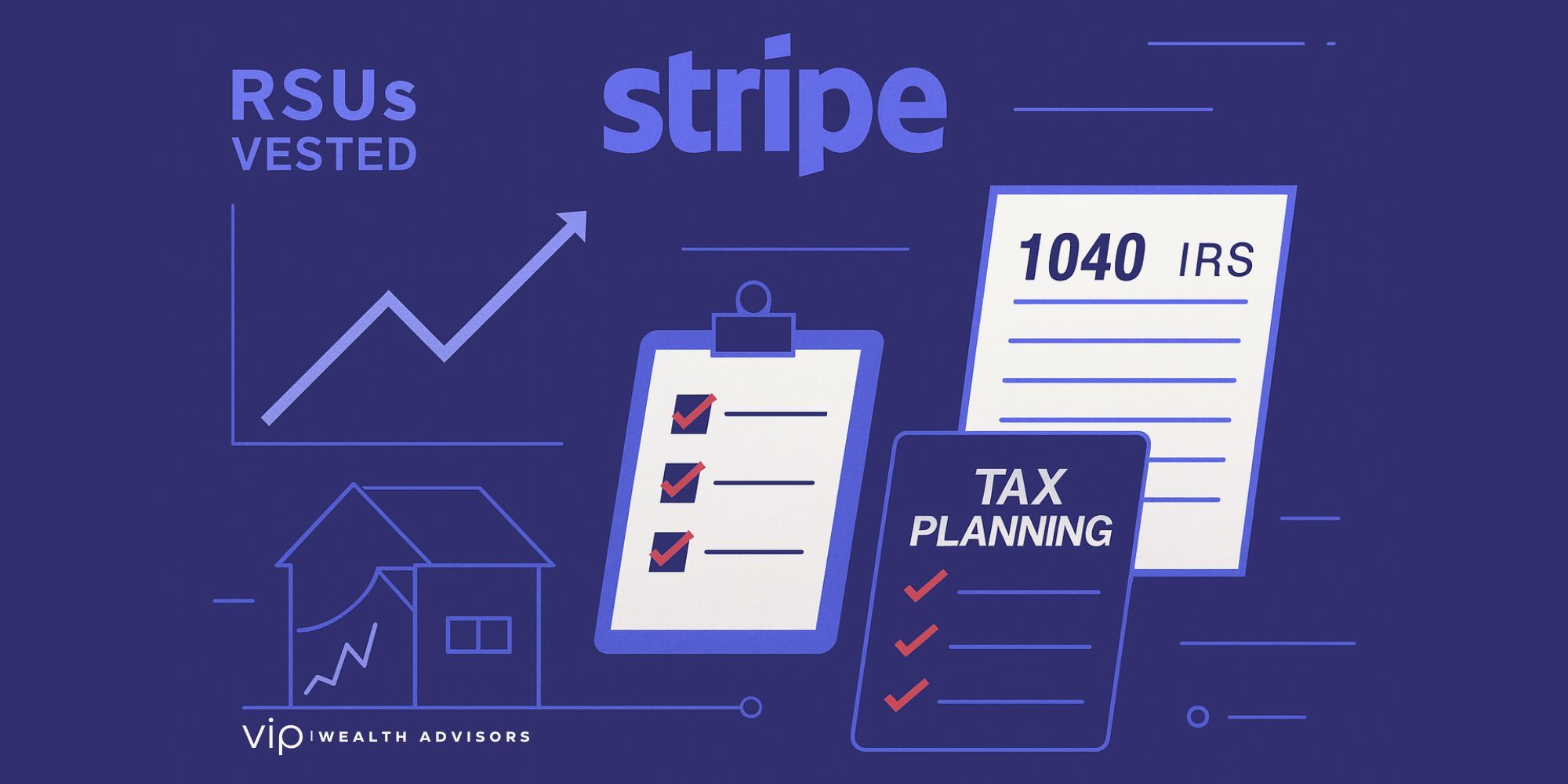Your Stripe Equity Just Vested—Now What?
Stripe, the global payments giant valued at over $65 billion, is one of the most anticipated IPOs in recent tech history. With a workforce of over 7,000 and operations spanning the globe, the company has been quietly building toward a public debut—likely within the next 12 to 18 months.
If you're a Stripe employee holding Restricted Stock Units (RSUs) or other equity, you're sitting on a potentially life-changing opportunity—but only if you plan strategically. Equity compensation at pre-IPO companies is riddled with tax traps, liquidity constraints, and hidden complexity.
Let's break down exactly how Stripe equity works—and what you should be doing right now.
🔍 How Equity Compensation Works at Stripe
Stripe primarily grants Restricted Stock Units (RSUs) as part of its employee compensation packages. Here's how their plan typically functions:
💼 Type of Equity: RSUs
- Stripe historically moved away from stock options and now offers Restricted Stock Units as the primary form of employee equity. These RSUs:
- Vest over four years, typically with a 1-year cliff followed by monthly vesting
- Are double-trigger—meaning they only convert to taxable income once two events occur:
- The shares vest (service-based)
- A liquidity event (IPO or secondary offering) happens
🧾 No Early Exercise or 83(b) Election
Because these are RSUs (not ISOs or NSOs), you cannot file an 83(b) election or exercise your shares early. Taxes are incurred when the RSUs are settled into stock after the IPO.
💰 Post-Vesting Liquidity Window
Stripe has held secondary liquidity events in the past (e.g., 2021), allowing some employees to sell shares privately. Once public, expect a standard 6-month lockup period before most employees can sell freely.
💡 The IPO Trigger: What Happens to Stripe RSUs
At IPO, Stripe RSUs will settle into stock and become taxable income, even if you don't sell them. That's the "second trigger." The IRS treats this as ordinary W-2 income based on the fair market value (FMV) of the shares on the day they vest.
Here's the catch:
You could owe tens or hundreds of thousands in taxes... before you've sold a single share.
📉 Example:
You vest 2,000 RSUs on the IPO day at a market value of $75 per share.
That's $150,000 in ordinary income added to your W-2.
You'll owe:
- Federal taxes (22%–37%)
- State taxes (depending on residency)
- Additional Medicare tax if applicable
If Stripe stock falls post-IPO (which is common), you could be paying tax on a paper gain that vanishes before you sell.
🧠 What Stripe Employees Often Get Wrong
Most people don't make bad equity decisions because they're reckless—they make them because no one ever helped them build a plan.
Here are the biggest mistakes I see:
1. Assuming the IPO = Cash Windfall
Without a plan for liquidity, tax withholding, and diversification, many people watch their wealth evaporate after vesting.
2. Underestimating the Tax Hit
Stripe will likely withhold ~22% at settlement—but you may owe 37% or more, especially if RSUs push you into a higher bracket. That surprise bill hits the following April, not at IPO.
3. Not Considering QSBS (Qualified Small Business Stock)
Suppose you own any early-stage Stripe shares via secondary purchases, grants, or investments. In that case, you may be eligible for QSBS, which could exempt up to $10 million in gains from federal taxes if properly structured.
4. Neglecting Tax-Loss Harvesting & Charitable Strategies
After IPO, you may want to gift appreciated stock to Donor-Advised Funds or use tax-loss harvesting to offset gains—but only if you've planned it out beforehand.
📈 Stripe Equity Strategy: What You Should Be Doing Now
Here's what I walk my clients through—often months (or years) before the IPO:
✅ Run a Pre-IPO Tax SimulationWe estimate your total tax bill across various vesting and stock price scenarios. This prevents blindside tax bills.
✅ Plan for Liquidity Events
We model what happens if you sell 25%, 50%, or all of your stock during post-IPO windows—and how to minimize taxes in each case.
✅ Explore QSBS Eligibility
If any of your equity predates Stripe's valuation crossing $50M or was acquired under the right conditions, you may qualify for huge tax savings.
✅ Coordinate Tax & Financial Planning
I don't just help you model a sell strategy—I handle your actual tax returns, AMT planning, and charitable giving so that everything works together.
📣 Why Work with Me?
Most financial advisors are either:
- Salespeople with an AUM minimum, or
- CPAs who don't understand your equity
I'm neither. I'm a flat-fee, tax-integrated advisor who works directly with high-income employees at companies like Stripe, Databricks, and Klarna. No product sales. No commissions. Just strategy and execution.
You've built your wealth. Now let's preserve it.
✳️ Next Step: Book a Complimentary Strategy Call
If you're a Stripe employee and want to maximize your equity, I'd be happy to help. Click below to schedule a personalized consultation where we'll review your grants, plan for the IPO, and model your options.
📅 Schedule your strategy session now
View More Articles by Topic
- Taxes (76)
- Financial Planning (40)
- Equity Compensation (34)
- Investments (23)
- RSU (21)
- Tax Policy & Legislation (18)
- Business Owner Planning (15)
- Incentive Stock Options (14)
- Retirement (14)
- Psychology of Money (10)
- Alternative Investments (9)
- Real Estate (9)
- AMT (8)
- Pre-IPO Planning (8)
- Estate Planning (7)
- Fiduciary Standard (6)
- NSOs (6)
- The Boring Investment Strategy (6)
- Capital Gains Tax (5)
- Crypto (5)
- QSBS (5)
- Post-IPO Tax Strategy (4)
- 401(k) Strategy (3)
- Private Investments (3)
- Q&A (3)
- Charitable Giving (2)
- ETF Taxes (2)
- IRA Strategy (2)
- International Financial Strategies (2)
- Irrevocable Trust (2)
- Legacy Wealth (2)
- Market Insights (2)
- Market Timing (2)
- Stock Market (2)
- Venture Capital (2)
- Video (2)
- AUM vs Flat Fee (1)
- Altruist (1)
- Atlanta (1)
- Book Review (1)
- Depreciation & Deductions (1)
- Education Planning (1)
- Precious Metals (1)
- QTIP Trust (1)
- Revocable Trust (1)
- Schwab (1)
- Solo 401k (1)








